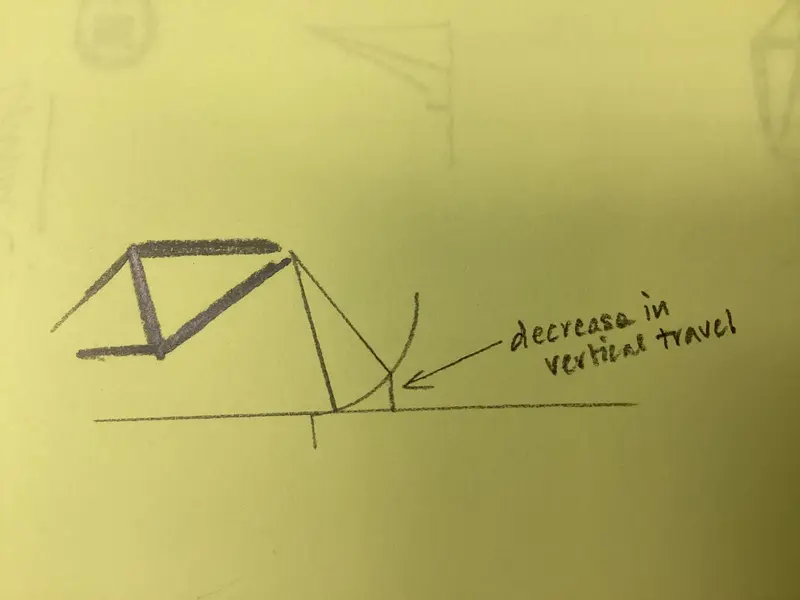2manyoranges
Old School Grand Master
- Feedback
- View
I freaked out everyone in the 1990s when I insisted on having 30% sag on my ProFlex 853, Amp B3 and Pace forks on my hardtails. 'It's a waste of travel' they said. 'there's no reason why...' they said. When I ordered soft elastomers for the ProFlex, Magic Cycles genuinely said 'you don't need them...you just don't need them....'. The bike worked brilliantly.
At 170 and 66kg I am certainly lightweight. But I do like hammering trails....
And I like my suspension to DROP into things as well as respond to bumps. Sag is a vital feature of suspension systems - it sets the mass hanging in a spring system rather than balanced on top.
i now have some long travel DH and ENDURO full suspension bikes, but love my hardtails. With 150mm and 160mm of front travel. WHAAAAT??? say friends. 'That's completely unnecessary' they say. 'when you burn through the travel you just upset the geometry of the bike....' they say.
I see it differently.
Stanton, for example, quote frame angles with a 140mm fork 25% into the sag.
This makes the available travel 105mm.
I use a 2deg angleset (works components) to slacken the head angle 1-2deg, which uses up around 15mm of travel. So my 160 fork is now a 145...which makes the available travel at 25% sag 120mm. I can now increase sag, and if I increase it to 30% (COTIC use 30% and PIPEDREAM 40%) then 145-43.5 = 102.5mm.
Which means a 160 fork gives me a tiny bit LESS travel than a 140 on 25% sag. Which is what the frame is designed for.
I now do not have a madly elevated bike, I have a lot more control all the time since I have increased trail and more suspension to drop into depressions when I ride, and I LIKE IT.
Being saggy that is.
One reason I know that this setup is good is that I get VERY good small bump sensitivity, good support, and at the end of a ride my marker ring is about 80% through the travel.
Of course, the magic setup for any fork is initial fast breakaway to deal with small bumps, then support in the midstroke, then rapid ramp up on really big hits. Getting that is a lot easier with longer forks, I think, since I can play with compression damping and rebound and have a more sensitive set of changes for any given adjustment. I am just wrangling a Cane Creek Helm COIL SPRING fork which is really promising on the bench - very low breakaway then good support in the mid stroke despite the linear nature of the spring. This is in the workshop. It will be interesting to see it in anger on the trail. I have yet to get a frame but I think a Pipedream Moxie, Kingdom Vendetta2, Cotic BfE last gen or Stanton Slackline gen3. Should be fun.
At 170 and 66kg I am certainly lightweight. But I do like hammering trails....
And I like my suspension to DROP into things as well as respond to bumps. Sag is a vital feature of suspension systems - it sets the mass hanging in a spring system rather than balanced on top.
i now have some long travel DH and ENDURO full suspension bikes, but love my hardtails. With 150mm and 160mm of front travel. WHAAAAT??? say friends. 'That's completely unnecessary' they say. 'when you burn through the travel you just upset the geometry of the bike....' they say.
I see it differently.
Stanton, for example, quote frame angles with a 140mm fork 25% into the sag.
This makes the available travel 105mm.
I use a 2deg angleset (works components) to slacken the head angle 1-2deg, which uses up around 15mm of travel. So my 160 fork is now a 145...which makes the available travel at 25% sag 120mm. I can now increase sag, and if I increase it to 30% (COTIC use 30% and PIPEDREAM 40%) then 145-43.5 = 102.5mm.
Which means a 160 fork gives me a tiny bit LESS travel than a 140 on 25% sag. Which is what the frame is designed for.
I now do not have a madly elevated bike, I have a lot more control all the time since I have increased trail and more suspension to drop into depressions when I ride, and I LIKE IT.
Being saggy that is.
One reason I know that this setup is good is that I get VERY good small bump sensitivity, good support, and at the end of a ride my marker ring is about 80% through the travel.
Of course, the magic setup for any fork is initial fast breakaway to deal with small bumps, then support in the midstroke, then rapid ramp up on really big hits. Getting that is a lot easier with longer forks, I think, since I can play with compression damping and rebound and have a more sensitive set of changes for any given adjustment. I am just wrangling a Cane Creek Helm COIL SPRING fork which is really promising on the bench - very low breakaway then good support in the mid stroke despite the linear nature of the spring. This is in the workshop. It will be interesting to see it in anger on the trail. I have yet to get a frame but I think a Pipedream Moxie, Kingdom Vendetta2, Cotic BfE last gen or Stanton Slackline gen3. Should be fun.
Last edited:
